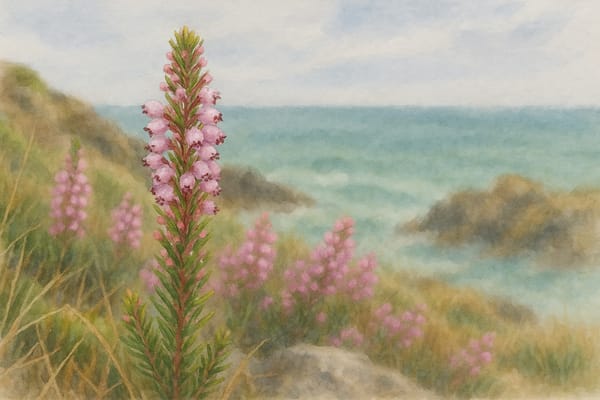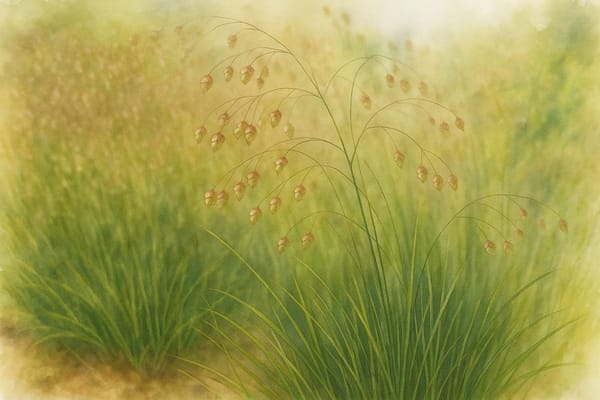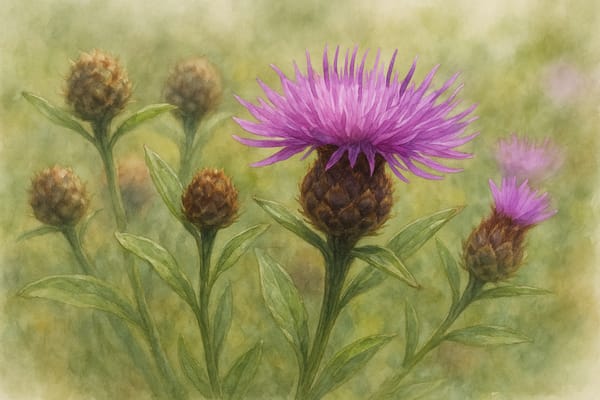A deep-rooted symbol of Cornish identity, beauty, and resilience with practical advice for coastal garden success
Cornish Heath (Erica vagans) isn’t just a heather — it’s Cornwall’s official county flower and a powerful symbol of identity, endurance, and connection to place. Native only to the Lizard Peninsula, its purple-pink blooms sweep across heathlands in late summer, capturing the essence of the region’s rugged beauty.
In this profile, we explore the plant’s cultural significance, historical role in Cornish tradition, why it’s protected by law, and how to grow it successfully in a coastal garden.
A Living Emblem of Cornwall
| Aspect | Symbolism in Cornish Heritage |
|---|
| County Flower | Pride, regional identity, and natural beauty |
| Literary & Artistic Motif | Inspiration in poetry, art, and local celebrations |
| Conservation Emblem | Commitment to protecting Cornwall’s unique environment |
| Folklore | Associated with good luck, protection, and resilience |
| Visual Icon | Featured in crests, public plantings, and Penzance’s coat of arms |
Cornish Heath’s importance runs deep in the county’s culture. Selected as Cornwall’s county flower for its rarity and beauty, it grows almost exclusively on the Lizard Peninsula’s acidic, sandy soils. It’s revered not only for its physical characteristics but also as a living symbol of the Cornish spirit—resilient, striking, and rooted in a challenging landscape.
Cornish Heath in Tradition, Folklore, and Poetry
Folklore and Legend
- Joseph of Arimathea Legend: A tale claims Joseph of Arimathea slept in a bed of Cornish Heath during his travels, blessing the plant for its comfort and hospitality.
- Spiritual Associations: In Cornish tradition, heathers are linked to good fortune, protection, and the endurance of life in harsh environments.
Literature and Artistic Use
- Poetic Imagery: Cornish Heath often appears in Cornish-language poetry and English verse as a metaphor for strength, place, and continuity.
- Visual Impact: Historic writers described it as "purple carpets" rolling across the moor, evoking emotion and pride.
Why Cornish Heath Is Protected
Cornish Heath is protected under UK law due to its limited range and ecological importance.
Legal Safeguards
- Wildlife and Countryside Act 1981 protects wild specimens from being uprooted or destroyed.
- SSSI and SAC Designations on the Lizard Peninsula protect its native heathland habitat.
- EU Habitats Directive (retained in UK law) recognises dry Atlantic coastal heath as a priority habitat.
Conservation Measures
| Action | Purpose |
| Heathland Restoration | Reintroduces grazing, removes scrub, maintains open acidic soils |
| Community Engagement | Raises awareness, involves local people in protection efforts |
| Controlled Burning | Prevents encroachment and rejuvenates habitats |
| Monitoring | Tracks health of Erica vagans populations and habitat quality |
Why Cornish Heath Thrives in Coastal Gardens
Unlike other heathers, Cornish Heath is uniquely suited to exposed, coastal environments.
Key Traits
- Salt and Wind Tolerance: Naturally adapted to sea air and gales.
- Drought Resistance: Once established, it handles dry, sandy soils with ease.
- Late Season Colour: Blooms from late summer into autumn.
- Pollinator Friendly: Supports bees and butterflies in coastal gardens.
Comparison Table
| Feature | Cornish Heath | Other Heathers |
| Native Range | Coastal Cornwall | Inland moorlands |
| Salt Tolerance | High | Low to moderate |
| Soil Type | Sandy, acidic | Acidic, but often peaty |
| Flowering | Late summer–autumn | Spring–summer (varies) |
| Wildlife Value | Excellent | Good |
How to Grow Cornish Heath in a Coastal Garden
Site Selection
- Full sun is ideal
- Provide wind protection if very exposed
Soil Preparation
- Acidic (pH 5.5–7), well-drained, sandy or loamy
- Avoid alkaline or heavy clay soils
Planting Tips
- Plant in spring or early autumn
- Allow 30–45 cm spacing for air flow and coverage
- Raised beds or containers with ericaceous compost work well if soil isn’t suitable
Care and Maintenance
- Water in dry spells; avoid overwatering
- Mulch annually with bark or leaf mould
- Light pruning after flowering
- Use ericaceous fertiliser in spring
Summary
Cornish Heath isn’t just a beautiful native plant—it’s a cultural treasure. Rooted in Cornwall’s identity, celebrated in legend and poetry, and flourishing in wild, windswept habitats, Erica vagans is ideal for coastal gardens that value both visual charm and environmental integrity.
Whether grown for its symbolism, low maintenance, or biodiversity benefits, it’s a truly Cornish addition to your garden.











